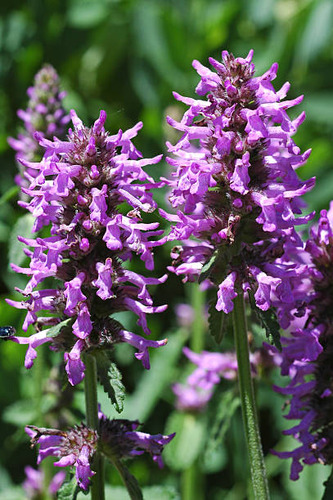
Introduction to Wood Betony Tincture Recipe
Are you seeking a natural remedy that has been cherished for centuries? In this “Wood Betony Tincture Recipe,” you’ll discover a single plant that can ease headaches, soothe your nerves, and support your overall well-being. First, meet wood betony—a botanical treasure with a rich history in traditional medicine. Next, in this guide, you’ll learn how to harness the potent healing properties of wood betony through a simple yet effective tincture recipe. Finally, get ready to embark on a journey to wellness with a time-honored herbal remedy that might just become your new favorite elixir. So, stay with us as we explore the secrets of crafting your very own wood betony tincture!
Brief Description, Origin, and History of Wood Betony
Wood Betony (Stachys officinalis) thrives as a perennial herb native to Europe and parts of Asia. Ancient cultures, particularly the Romans and Greeks, revered Wood Betony for its medicinal properties. They used it to treat various ailments, such as headaches and digestive issues. Its Latin name, “Stachys,” translates to “ear of grain” due to the shape of its flower spikes. The term “officinalis” signifies its medicinal use.
Throughout history, folklore imbued Wood Betony with magical qualities. People believed it could ward off evil spirits. Consequently, they often planted it in churchyards for protection. Nowadays, herbalists still value Wood Betony for its calming and restorative properties. Furthermore, many continue to rely on it as a natural remedy.
In medieval times, Wood Betony enjoyed widespread use. For instance, monasteries often included it in their gardens, recognizing its healing potential. Additionally, herbalists would prepare tinctures and teas from the plant. These preparations aimed to treat various ailments and promote overall health. Despite advancements in modern medicine, Wood Betony remains a cherished herb in traditional healing practices.
All About Wood Betony for Health
Wood Betony offers numerous health benefits. Its ability to support the nervous system makes it a valuable herb. Moreover, it can alleviate headaches and improve digestive health. Compounds like tannins, saponins, and flavonoids contribute to its healing properties.
Research shows that Wood Betony can reduce anxiety. It also helps relieve tension headaches. Furthermore, it aids in digestion. The herb’s anti-inflammatory and antispasmodic properties make it versatile for many health issues.
In addition to these benefits, Wood Betony supports overall wellness. Its calming effects promote relaxation. This makes it an excellent choice for stress relief. Additionally, it can enhance cognitive function. Regular use of Wood Betony may improve mental clarity and focus.
Moreover, Wood Betony’s anti-inflammatory properties benefit joint health. It can help reduce pain and swelling associated with arthritis. Additionally, the herb may boost the immune system. This helps the body fight off infections and illnesses. For these reasons, Wood Betony proves to be a comprehensive natural remedy.
Common Applications of How Wood Betony is Used
Wood Betony can be used in various forms to address different health concerns. Here are some common applications:
- Tinctures: Made by soaking the herb in alcohol, tinctures are a concentrated way to benefit from Wood Betony’s properties.
- Teas: Brewing Wood Betony leaves can create a soothing tea that helps with digestion and relaxation.
- Capsules: For those who prefer supplements, Wood Betony capsules are available for easy consumption.
- Essential Oils: Used in aromatherapy, Wood Betony essential oil can help alleviate stress and improve mood.
- Poultices: Applied directly to the skin, Wood Betony can help reduce inflammation and heal minor wounds.
Tips for Taking Wood Betony Effectively
To get the most out of Wood Betony, consider these tips:
- Consistency: Take Wood Betony regularly to see its full benefits.
- Dosage: Follow recommended dosages on product labels or consult a healthcare provider.
- Form: Choose the form that best fits your lifestyle, whether it’s tinctures, teas, or capsules.
- Timing: Some benefits, like improved sleep, may be more noticeable if taken at specific times of the day.
- Combination: Pair Wood Betony with other herbs for synergistic effects, such as valerian for sleep or peppermint for digestion.
What Are the Characteristics of a Good-Quality Wood Betony
When selecting Wood Betony, look for the following qualities:
- Organic Certification: Ensures the herb is free from pesticides and chemicals.
- Freshness: Check the color and smell – vibrant green leaves and a strong, pleasant aroma indicate freshness.
- Source: Know the origin of the herb; reputable suppliers are more likely to offer high-quality products.
- Processing Method: Opt for products that use gentle drying and processing methods to retain the herb’s potency.
- Packaging: Airtight, opaque packaging helps preserve the herb’s properties.
Interesting Facts About the Benefits of Wood Betony Essential Oil
Wood Betony essential oil is packed with surprising benefits:
- Stress Relief: Its calming scent helps reduce anxiety and promote relaxation.
- Pain Relief: Can be used topically to soothe muscle aches and tension.
- Skin Health: Helps in healing minor wounds and reducing inflammation.
- Digestive Aid: Aromatherapy with Wood Betony can improve digestion and reduce bloating.
- Sleep Aid: Promotes better sleep by calming the mind and reducing stress.
How Can You Create Your Home Remedy with Wood Betony?
Creating a home remedy of Wood Betony tincture recipe is simple and rewarding. Here’s how you can make your own tincture:
- Gather Supplies: You’ll need dried Wood Betony, a glass jar, and high-proof alcohol (like vodka).
- Combine Ingredients: Fill the jar halfway with dried Wood Betony, then cover with alcohol, leaving some space at the top.
- Seal and Store: Seal the jar and store it in a cool, dark place for 4-6 weeks, shaking it occasionally.
- Strain: After 4-6 weeks, strain the mixture through a cheesecloth into a clean jar.
- Use: Your Wood Betony tincture is now ready to use. Store it in a dark glass bottle away from sunlight.
How to Properly Store and Preserve Wood Betony for Long-Term Use
Proper storage is key to maintaining Wood Betony’s potency. Follow these tips:
- Cool, Dark Place: Store dried herbs and tinctures in a cool, dark place to prevent degradation.
- Airtight Containers: Use airtight containers to keep out moisture and air.
- Labeling: Clearly label jars with the date of preparation to keep track of freshness.
- Avoid Direct Sunlight: Keep products away from direct sunlight, which can degrade their potency.
- Periodic Checks: Check your stored herbs periodically for signs of mold or spoilage.
Who Should Avoid Wood Betony and Any Contraindications
While Wood Betony is generally safe, there are some precautions to consider:
- Pregnancy and Breastfeeding: Avoid using Wood Betony if you are pregnant or breastfeeding without consulting a healthcare provider.
- Low Blood Pressure: Wood Betony can lower blood pressure, so avoid it if you already have low blood pressure or are on medication for it.
- Surgery: Stop using Wood Betony at least two weeks before scheduled surgery due to its blood pressure-lowering effects.
- Allergic Reactions: If you experience any allergic reactions, discontinue use immediately.
- Consult Healthcare Provider: Always consult with a healthcare provider before starting any new herbal remedy, especially if you have underlying health conditions or are taking other medications.
Practical Tips for Integrating Wood Betony Herbs into Your Life
Incorporating Wood Betony herbs into your life proves simple and enjoyable. Here are some practical tips to get you started:
- Morning Tea: Begin your day with a calming cup of Wood Betony tea. Its soothing properties help set a peaceful tone for the day ahead. Simply steep dried Wood Betony leaves in hot water for a few minutes. Enjoy the warm, earthy flavor and the sense of calm it brings.
- Evening Tincture: Use a few drops of Wood Betony tincture in the evening to help unwind. This can aid in promoting restful sleep. Add the tincture to a glass of water or a warm beverage. Savor the relaxing effects as you prepare for a good night’s sleep.
- Aromatherapy: Diffuse Wood Betony essential oil to create a calming atmosphere at home. Its pleasant aroma helps reduce stress and anxiety. You can also add a few drops to a warm bath for a soothing soak. The steam will carry the beneficial properties of the oil, enhancing relaxation.
- Cooking: Add Wood Betony leaves to soups and stews for added flavor and health benefits. The herb complements a variety of dishes, adding a unique, slightly bitter taste. It’s an easy way to incorporate its medicinal properties into your diet.
- Gardening: Grow Wood Betony in your garden for easy access to fresh herbs. The plant thrives in well-drained soil and partial shade. It also attracts pollinators like bees and butterflies. Harvest the leaves as needed for teas, tinctures, and culinary uses.
Conclusion
Wood Betony tincture stands out as a versatile and powerful addition to your natural health toolkit. From its rich history to its numerous health benefits, this herb offers a natural way to support your wellbeing. Embrace the power of Wood Betony and discover how it can enhance your health and happiness.
Firstly, the herb’s calming properties make it ideal for stress relief. Regular use can promote a sense of tranquility and reduce anxiety. Secondly, its digestive benefits support a healthy gut. Incorporating Wood Betony into your routine may alleviate digestive discomfort and improve overall digestive health.
Additionally, Wood Betony’s anti-inflammatory properties benefit joint health. It can help reduce pain and swelling associated with arthritis. Furthermore, the herb may boost the immune system, helping your body fight off infections and illnesses. By incorporating Wood Betony tincture into your daily routine, you can enjoy these varied health benefits.
Moreover, Wood Betony proves to be a practical and accessible herb. Whether you choose to make tea, use a tincture, or grow it in your garden, integrating it into your life is straightforward. Its versatility allows you to tailor its use to your specific needs and preferences.
In conclusion, Wood Betony tincture offers a holistic approach to health and wellness. Its numerous benefits and practical applications make it a valuable addition to any natural health regimen. Explore the potential of this ancient herb and experience the positive impact it can have on your life. Embrace the tradition and healing power of Wood Betony.
FAQs about Wood Betony Tincture Recipe
What is Wood Betony tincture used for? Wood Betony tincture supports the nervous system, alleviates headaches, improves digestion, and reduces anxiety. Additionally, it can help with overall relaxation and stress relief.
How do you make a tincture from Wood Betony? You can make a Wood Betony tincture by combining dried Wood Betony with high-proof alcohol in a glass jar. Then, seal the jar and let it sit for 4-6 weeks. After that, strain the mixture and store it in a dark glass bottle.
Can Wood Betony be taken daily? Yes, you can take Wood Betony daily. However, always follow the recommended dosages and consult a healthcare provider if you have any health concerns. Moreover, consistency will help you see the best results.
Are there any side effects of Wood Betony? Wood Betony is generally safe, but it can lower blood pressure. Therefore, pregnant or breastfeeding women, and those with low blood pressure or on medication, should consult a healthcare provider before use.
Where can I buy high-quality Wood Betony? You can purchase high-quality Wood Betony from reputable herbal suppliers, health food stores, or online retailers specializing in organic herbs. Always check for organic certification to ensure quality.
